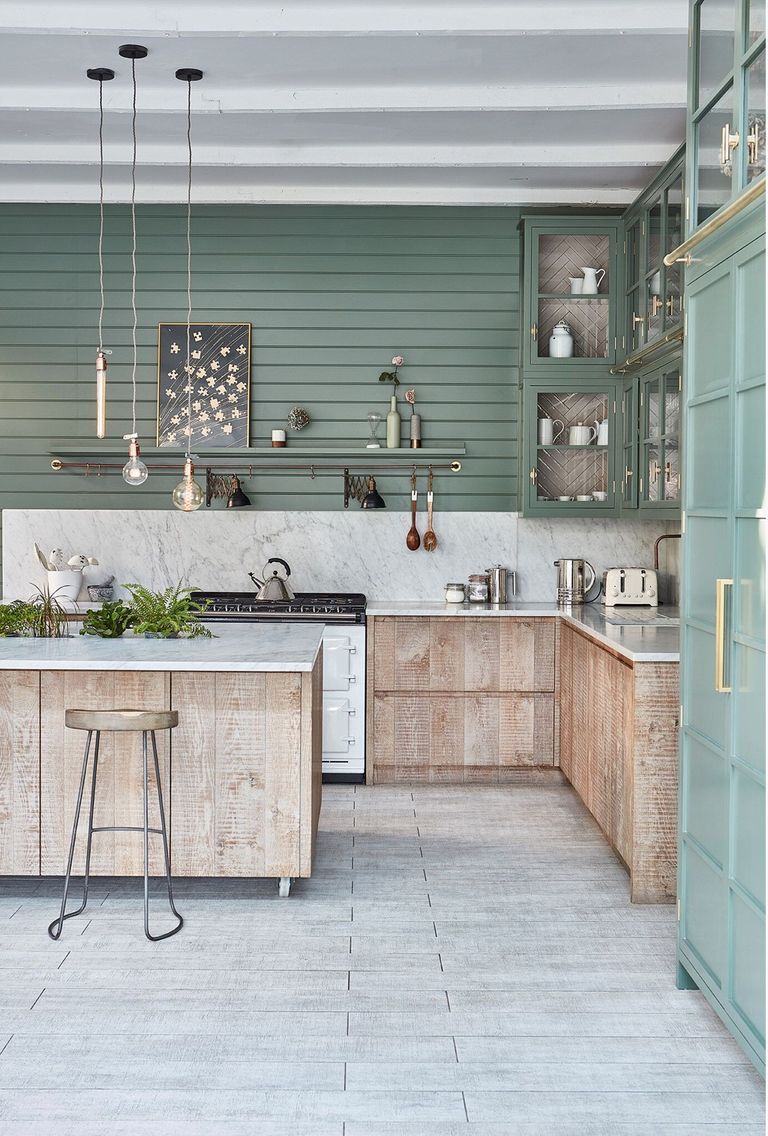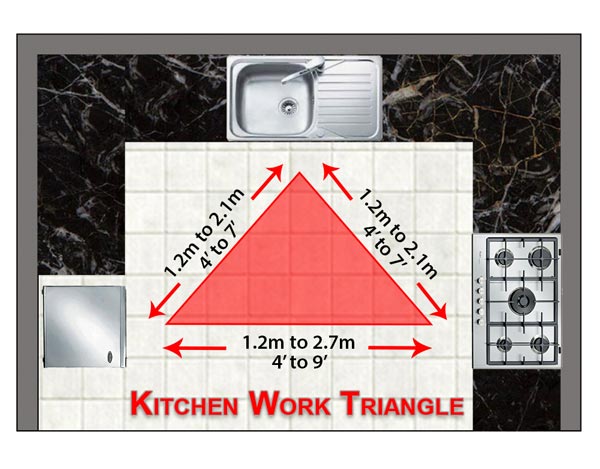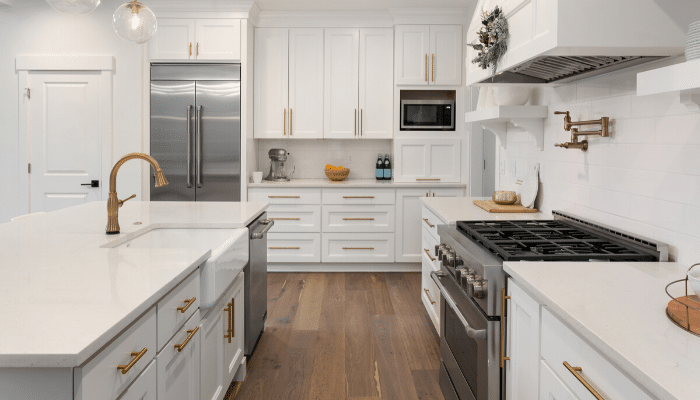1. Kitchen Design: The Triangle Rule
When it comes to designing a kitchen, one of the most important concepts to keep in mind is the triangle rule. This rule refers to the placement and proximity of the three main work areas in a kitchen: the sink, the stove, and the refrigerator. By understanding and implementing the triangle rule in your kitchen design, you can create a functional and efficient space that makes cooking and preparing meals a breeze.
2. How to Use the Triangle Rule in Kitchen Design
The first step in using the triangle rule is to determine the best placement for each of the three main work areas. These areas should form a triangle shape, with each point of the triangle representing one of the work areas. The distance between each point should ideally be between 4 and 9 feet, with the total sum of all three sides of the triangle being between 12 and 26 feet.
Besides the placement of the work areas, it's also important to consider the flow of traffic in your kitchen. The triangle should be easily accessible and not obstructed by other elements in the kitchen, such as cabinets or islands. This will ensure that you can move seamlessly between the three work areas without any obstructions.
3. The Importance of the Triangle Rule in Kitchen Design
So why is the triangle rule so important in kitchen design? For one, it promotes efficiency and convenience. By having the three main work areas in close proximity to each other, you can easily move between them while cooking, reducing the time and effort it takes to prepare a meal.
The triangle rule also helps to create a more ergonomic kitchen. With the work areas in close proximity, you won't have to stretch or strain to reach for items, minimizing the risk of injury. This is especially important if you spend a lot of time in the kitchen.
4. Tips for Implementing the Triangle Rule in Kitchen Design
When implementing the triangle rule in your kitchen design, there are a few tips to keep in mind:
5. The Triangle Rule: A Key Concept in Kitchen Design
The triangle rule is a key concept in kitchen design for a reason. It not only promotes efficiency and functionality, but it also creates a visually appealing layout. The triangle shape is aesthetically pleasing and can contribute to the overall design of your kitchen.
Additionally, the triangle rule can add value to your home. Potential buyers will appreciate a well-designed and functional kitchen, making the triangle rule a smart investment in your home.
6. Understanding the Triangle Rule for Efficient Kitchen Design
To fully understand the importance of the triangle rule, it's important to know the purpose of each of the three main work areas.
7. The Triangle Rule: Creating a Functional Kitchen Layout
By following the triangle rule, you can create a functional and efficient kitchen layout that works for you. However, it's important to keep in mind that the triangle rule is just a guideline and can be adjusted to fit your specific needs and preferences.
For example, if you have multiple people who work in the kitchen at the same time, you may want to consider creating multiple triangles to accommodate everyone. Or, if you have a larger kitchen, you may want to expand the triangle beyond the recommended size to allow for more workspace.
8. Applying the Triangle Rule to Your Kitchen Design
When designing your kitchen, it's important to keep the triangle rule in mind from the very beginning. This will ensure that all elements of your kitchen, such as cabinets, appliances, and countertops, are placed in a way that follows the rule.
If you're remodeling your kitchen, it may be more challenging to incorporate the triangle rule, especially if you're working with an existing layout. However, with some creativity and planning, you can still achieve a functional and efficient kitchen by following the triangle rule as closely as possible.
9. The Triangle Rule: Maximizing Space in Your Kitchen Design
In addition to promoting efficiency, the triangle rule can also help you maximize space in your kitchen. By keeping the three main work areas in close proximity, you can free up more space for other elements, such as a kitchen island or dining area.
Furthermore, by following the recommended size guidelines for the triangle, you can ensure that your kitchen doesn't feel cramped or cluttered. This is especially important in smaller kitchens where space is limited.
10. Common Mistakes to Avoid When Using the Triangle Rule in Kitchen Design
While the triangle rule is a valuable concept in kitchen design, there are some common mistakes that people make when implementing it:
The Importance of the Triangle Rule in Kitchen Design

Creating a Functional and Efficient Kitchen Layout
 When it comes to designing a kitchen, one of the most crucial factors to consider is the layout. A well-designed kitchen layout not only contributes to the overall aesthetics of your home, but it also plays a significant role in its functionality and efficiency. This is where the triangle rule for kitchen design comes into play.
The triangle rule, also known as the work triangle, is a design principle that is based on the idea that the three main work areas in a kitchen – the sink, stove, and refrigerator – should form a triangle. This means that these three areas should be in close proximity to each other, but not too close to cause congestion and not too far to create inconvenience.
Efficiency and Accessibility
By following the triangle rule, you can create a kitchen layout that promotes efficiency and accessibility. Having the three main work areas positioned in a triangular shape allows for efficient movement between them, making it easier to complete tasks in the kitchen. For instance, when cooking, you can easily move from the stove to the sink to wash vegetables, and then to the refrigerator to grab ingredients without having to walk long distances.
Moreover, the triangle rule ensures that these areas are easily accessible, reducing the risk of accidents and injuries in the kitchen. Imagine having to navigate through a cluttered kitchen to get from the stove to the sink – not only can this be frustrating, but it also increases the chances of accidents occurring.
Aesthetics and Space Optimization
Aside from functionality and efficiency, the triangle rule also plays a significant role in the aesthetics and space optimization of your kitchen. By positioning the three main work areas in a triangular shape, you create a balanced and visually appealing layout. This is especially important for open-concept kitchens, where the kitchen is visible from other areas of the house.
Furthermore, the triangle rule helps optimize the use of space in your kitchen. By keeping the three main work areas close to each other, you free up more space for other kitchen elements such as cabinets, countertops, and appliances. This allows for a more organized and clutter-free kitchen, making it easier to prepare meals and entertain guests.
In conclusion, the triangle rule is a crucial aspect of kitchen design that should not be overlooked. By following this design principle, you can create a functional, efficient, and visually appealing kitchen layout that will not only make your daily tasks easier but also add value to your home. So, the next time you're planning a kitchen renovation or remodel, make sure to keep the triangle rule in mind.
When it comes to designing a kitchen, one of the most crucial factors to consider is the layout. A well-designed kitchen layout not only contributes to the overall aesthetics of your home, but it also plays a significant role in its functionality and efficiency. This is where the triangle rule for kitchen design comes into play.
The triangle rule, also known as the work triangle, is a design principle that is based on the idea that the three main work areas in a kitchen – the sink, stove, and refrigerator – should form a triangle. This means that these three areas should be in close proximity to each other, but not too close to cause congestion and not too far to create inconvenience.
Efficiency and Accessibility
By following the triangle rule, you can create a kitchen layout that promotes efficiency and accessibility. Having the three main work areas positioned in a triangular shape allows for efficient movement between them, making it easier to complete tasks in the kitchen. For instance, when cooking, you can easily move from the stove to the sink to wash vegetables, and then to the refrigerator to grab ingredients without having to walk long distances.
Moreover, the triangle rule ensures that these areas are easily accessible, reducing the risk of accidents and injuries in the kitchen. Imagine having to navigate through a cluttered kitchen to get from the stove to the sink – not only can this be frustrating, but it also increases the chances of accidents occurring.
Aesthetics and Space Optimization
Aside from functionality and efficiency, the triangle rule also plays a significant role in the aesthetics and space optimization of your kitchen. By positioning the three main work areas in a triangular shape, you create a balanced and visually appealing layout. This is especially important for open-concept kitchens, where the kitchen is visible from other areas of the house.
Furthermore, the triangle rule helps optimize the use of space in your kitchen. By keeping the three main work areas close to each other, you free up more space for other kitchen elements such as cabinets, countertops, and appliances. This allows for a more organized and clutter-free kitchen, making it easier to prepare meals and entertain guests.
In conclusion, the triangle rule is a crucial aspect of kitchen design that should not be overlooked. By following this design principle, you can create a functional, efficient, and visually appealing kitchen layout that will not only make your daily tasks easier but also add value to your home. So, the next time you're planning a kitchen renovation or remodel, make sure to keep the triangle rule in mind.























































